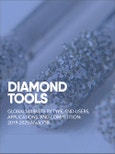With over 20 years experience covering the diamond tools industry, this intelligence coverage offers the most comprehensive data and analysis available. The Published Research Report, now in its 6th Edition, and the Ulysses database platform both build on that wealth of accumulated knowledge.
The diamond tools report provides quantitative data and qualitative analysis on the global market by country, end-user industry, tool type, application, and competitors. Expanded coverage includes additional end-user industry breakdowns, and in-depth producer profiles.
Quantitative and qualitative analysis is presented for 2021 through 2027.
Research Objectives
- The primary objectives in this analysis are:
- To provide clients with the tools they need to accurately assess their market opportunities and potential;
- To determine the size of the total market opportunity by diamond tool product types, end-user industry, and country/regional demand;
- To forecast future growth in each product by geographic and end-use market; and
- To assess the competitive environment within the market including supplier sales, market share, and producer profiles.
Product Types Covered
- Saw Blades
- Wire Saws
- Grinding Wheels
- Drill Bits
- Gang Saws
- Core Drills
- Band Saws
- Dressers
- Hand Tools
- Milling Tools
- Turning Tools
- Pads/Discs
- Other
Geographic Coverage
- Brazil
- China
- CIS
- France
- Germany
- India
- Italy
- Japan
- Korea (South)
- Russia
- Spain
- Switzerland
- Taiwan
- United Kingdom
- United States
- Other Asia/Pacific
- Other EU
- Other Europe
- Other Latin America
- Other NAFTA
- Rest of World
End-User Industries
- Stone
- Construction
- Woodworking
- Machinery
- Transportation
- Electronic/Optoelectronic
Applications Covered
- Polishing/Lapping
- Finishing/Deburring
- Stock Removal
- Grinding
- Contouring
- Planing
- Sharpening
- Boring
- Other
Table of Contents
Methodology
Research Methodology
All current market and competitive intelligence techniques are employed in order to ensure comprehensive research and analysis. The research methodology outlined here applies generally to all database services, published and custom research. Of course, it is regularly modified to suit a project and the client’s greater objectives.
Identification of Report & Client Objectives
Typically, a face-to-face interview with individual clients or based on industry need, this stage is intended to coordinate and develop specific goals, what the objectives are and how best to activate the anticipated research.
Research Program Development
This includes the outlining of a research program employing a multi-pronged approach, including data collection and analysis. Also, established in this phase are time-frame of report completion & delivery and matters of budget.
Preparatory Research & Program Planning
Upon initiation of any data program, an exhaustive search is conducted to locate and obtain any background information pertinent to the project.
Secondary Data Collection
Our first step is the collection and analysis of information contained within the existing databases which cover 20 years of global technological and market development. Thus we are well-positioned to examine historical trends as well as future forecasts.
Our next step is the gathering of current information through sources such as subscription-based trade magazines, newspapers, scientific journals, governement manufacturing data, patent databases, end-user industry data such as manufacturing output, and company financial data. Relevant company information includes product literature, financial history, R&D trends and end-use market strategies. We perform both a top-down and a bottom-up approach, meaning we conduct analyses of demand-based factors such as product end-use by value and volume, as well as supply-side factors such as producer sales by product.
Primary Data Collection/Interviews
This step is crucial in having a true understanding of market factors. It involves the performance of person-to-person interviews with important figures that have influence and experience in the subject market. Interview candidates typically include senior executives, marketing executives, product managers, technical operators, as well as financial personnel and policy makers active in the market.
Further, a large roster of knowledgeable contacts across many sectors has been built up. We have fostered relationships through our proprietary approach which is based on integrity, mutual respect, and confidentiality. As mentioned, this step is the foundation of good research.
Quantitative and Qualitative Analysis
Upon completion of the previous research stages, the data and information will be tabulated and analyzed according to standard market intelligence principles and methods such as Porter's Five Forces, SWOT, weighted averaging, competitive analysis, modeling practices, and forecasting.
Each step of analysis is carefully done in order to achieve the most accurate results. Sometimes it becomes necessary to revise assumptions and conclusions. In that case, we do not hesitate to go back to the research stage to clarify results. Further, we always allow for these contingencies in our program planning so as to not waste valuable time.
Data Presentation
Data presentation includes tabular and graphical representations. Any accompanying analysis is clearly written in both narrative and bullet form for ease of understanding and clarity. Final delivery is normally through digital means, such as Excel tables and PDF files, but can be done in hard copy upon request.
In the case of the online data subscription service, data is presented in tabular form, easily searchable and customizable using boolean search functions. Clients also have the ability to generate custom charts and graphs based on their search criteria and output them in convenient formats.

LOADING...








